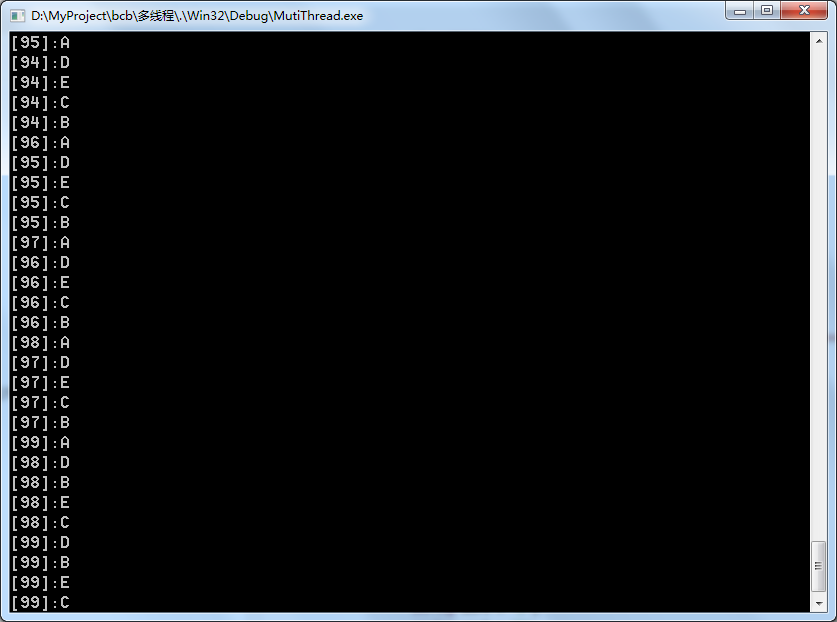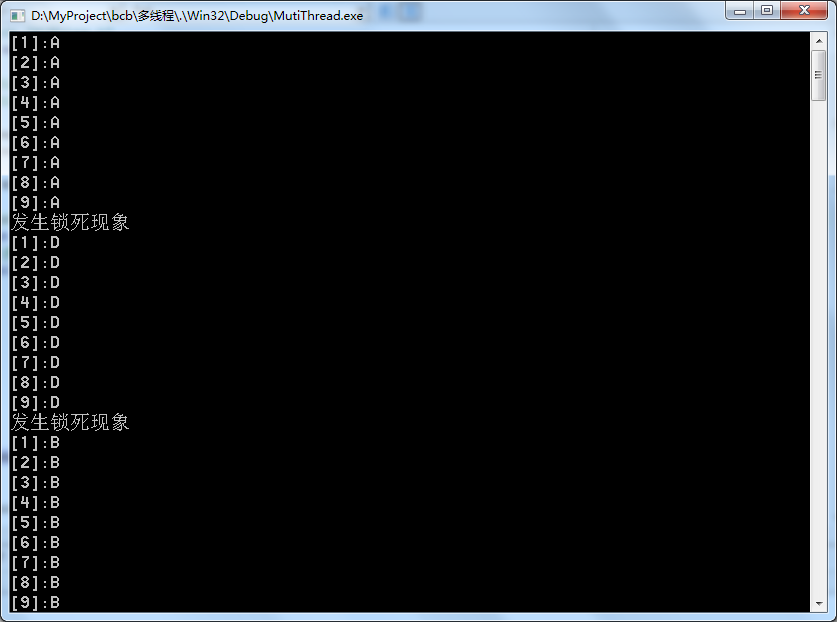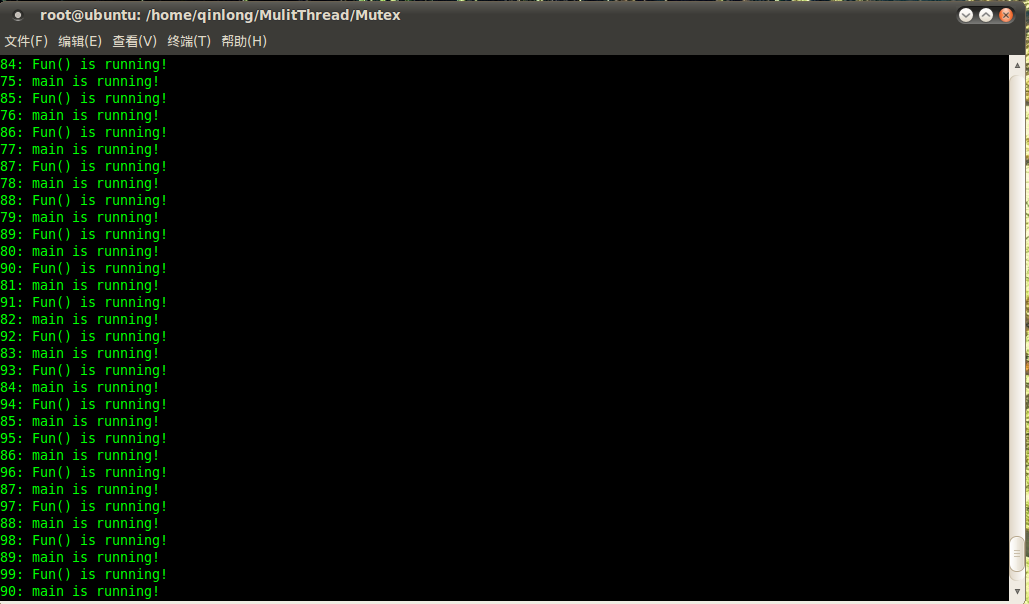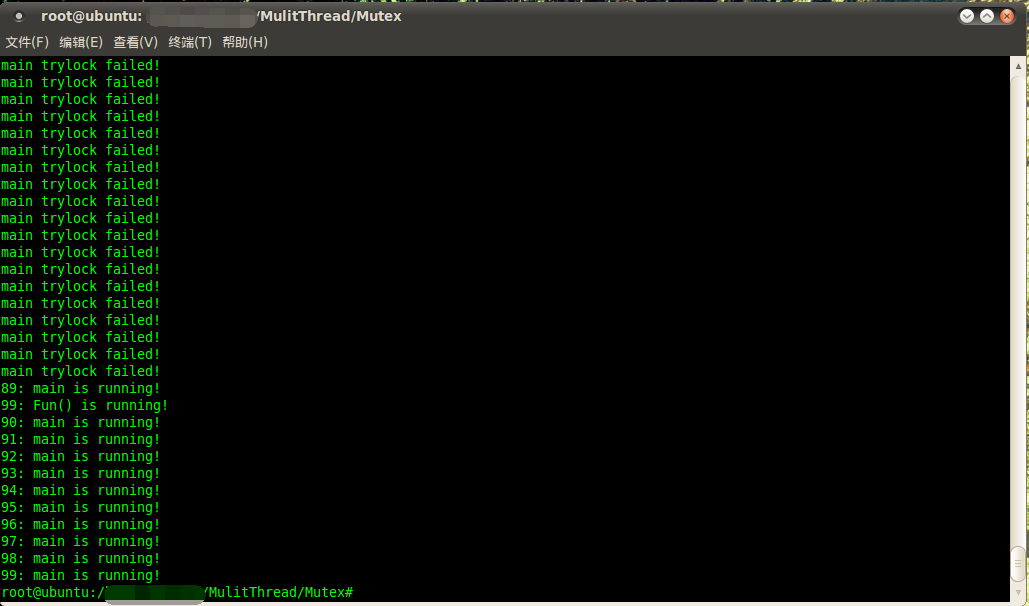一、互斥量Mutex同步多线程
1、Win32平台
相关函数和头文件
1 #include <windows.h>
2 HANDLE CreateMutex(
3 LPSECURITY_ATTRIBUTESlpMutexAttributes, // 指向安全属性的指针
4 BOOLbInitialOwner, // 初始化互斥对象的所有者
5 LPCTSTRlpName // 指向互斥对象名的指针
6 );
7
8 DWORD WINAPI WaitForSingleObject(
9 __in HANDLE hHandle,//互斥量对象句柄
10 __in DWORD dwMilliseconds//等待时间
11 );
12
13 BOOL WINAPI ReleaseMutex(HANDLE hMutex);
14 返回值:BOOL,TRUE表示成功,FALSE表示失败。
15 参数表:hMutex:HANDLE,制定一个互斥体的句柄。
16
17 BOOL CloseHandle(HANDLE hObject);
18 参数: hObject 代表一个已打开对象handle。
19 返回值:
20 TRUE:执行成功;
21 FALSE:执行失败,可以调用GetLastError()获知失败原因。
源码:
从本篇开始,我对代码会进行一些封装,使之更贴近实际使用的情况。
1 /***MyMutex.h头文件***/
2
3 #ifndef __MY_MUTEX_H
4 #define __MY_MUTEX_H
5 #include <windows.h>
6
7 class CMyMutex
8 {
9 public:
10 CMyMutex();
11
12 virtual ~CMyMutex();
13
14 void Lock();
15
16 void UnLock();
17
18 private:
19 HANDLE m_hMutex;
20 };
21
22 class CAutoLock
23 {
24 public:
25 CAutoLock(CMyMutex* pMutex);
26
27 virtual ~CAutoLock();
28
29 private:
30 CMyMutex* m_pMutex;
31 };
32
33 #endif;
1 /***MyMutex.cpp文件***/
2
3 #include <iostream>
4 #include <windows.h>
5 #include "MyMutex.h"
6
7 using namespace std;
8
9 CMyMutex::CMyMutex()
10 {
11 m_hMutex = CreateMutex(NULL /*默认安全属性*/
12 , false /*创建线程不拥有该信号量*/
13 , NULL /*锁名称*/
14 );
15 }
16
17 CMyMutex::~CMyMutex()
18 {
19 if(NULL != m_hMutex)
20 {
21 CloseHandle(m_hMutex);
22 cout<<"m_hMutex被关闭"<<endl;
23 }
24 }
25
26 void CMyMutex::Lock()
27 {
28 if(NULL == m_hMutex)
29 {
30 cout<<"m_hMutex为空"<<endl;
31 return;
32 }
33 DWORD dRes = -1;
34 dRes = WaitForSingleObject(m_hMutex, INFINITE);
35 if(WAIT_OBJECT_0 == dRes)
36 {
37 // cout<<"上锁成功!"<<endl;
38 }
39 else if(WAIT_ABANDONED == dRes)
40 {
41 cout<<"发生锁死现象"<<endl;
42 }
43 else if(WAIT_TIMEOUT == dRes)
44 {
45 cout<<"等待超时"<<endl;
46 }
47 else if(WAIT_FAILED == dRes)
48 {
49 cout<<"发生错误"<<endl;
50 }
51 else
52 {
53 cout<<"上锁失败!"<<endl;
54 }
55
56 }
57
58 void CMyMutex::UnLock()
59 {
60 ReleaseMutex(m_hMutex);
61 }
62
63 //****************************CAutoLock*****************************************
64 CAutoLock::CAutoLock(CMyMutex* pMutex)
65 {
66 m_pMutex = pMutex;
67 m_pMutex->Lock();
68 }
69
70 CAutoLock::~CAutoLock()
71 {
72 m_pMutex->UnLock();
73 }
1 /***main.cpp文件***/
2
3 #include <iostream>
4 #include <windows.h>
5 #include "MySemaphore.h"
6 #include "MyMutex.h"
7 using namespace std;
8
9 CMyMutex MyMutex;/*声明一个全局的互斥量对象(自己封装的)*/
10
11 DWORD WINAPI Fun(LPVOID lpParamter)
12 {
13 string strPrint((const char*)lpParamter);
14 int iRunTime = 0;
15 //执行100次跳出
16 while(++iRunTime<100)
17 {
18 /*利用CMyMutex的构造函数和析构函数分别取创建和关闭互斥量
19 利用CAutoLock的构造和析构函数去WaitForSingleObject和ReleaseMutex互斥量
20 */
21 CAutoLock cLock(&MyMutex);
22 cout <<"["<< iRunTime <<"]:"<< strPrint.c_str()<<endl;
23 //线程函数阻塞,交出CPU使用权限
24 Sleep(10);
25 }
26 return 0;
27 }
28
29 int main()
30 {
31 //创建子线程
32 string str1 = "A";
33 string str2 = "B";
34 string str3 = "C";
35 string str4 = "D";
36 string str5 = "E";
37
38 HANDLE hThread1 = CreateThread(NULL, 0, Fun, (void*)str1.c_str(), 0, NULL);
39 HANDLE hThread2 = CreateThread(NULL, 0, Fun, (void*)str2.c_str(), 0, NULL);
40 HANDLE hThread3 = CreateThread(NULL, 0, Fun, (void*)str3.c_str(), 0, NULL);
41 HANDLE hThread4 = CreateThread(NULL, 0, Fun, (void*)str4.c_str(), 0, NULL);
42 HANDLE hThread5 = CreateThread(NULL, 0, Fun, (void*)str5.c_str(), 0, NULL);
43
44 //关闭线程
45 CloseHandle(hThread1);
46 CloseHandle(hThread2);
47 CloseHandle(hThread3);
48 CloseHandle(hThread4);
49 CloseHandle(hThread5);
50
51 getchar();
52 // system("pause");
53 return 0;
54 }

运行结果:
五个线程分别打印字符串A到E,各执行99次,没有出现打印混乱(对屏幕资源进行争夺)的情况。
另外有兴趣的读者可以把代码敲一遍,每个线程打印9次,然后把CAutoLock的析构函数内的 m_pMutex->UnLock();注释起来会出现什么情况?可以思考一下。

运行结果:
出现的现象是:每个线程打印了9次就出现了“发生死锁现象”,而且打印A的线程居然可以不停的对m_pMutex->Lock();这是为什么呢?
WAIT_ABANDONED 0x00000080:当hHandle为mutex时,如果拥有mutex的线程在结束时没有释放核心对象会引发此返回值。这就是为什么会打印“发生死锁现象”,可能这里的提示写的不是很恰当。
另外可以重复执行m_pMutex->Lock();是因为打印A线程从最开始已经WaitForSingleObject到该互斥量,并且处于有信号状态,因此该线程可以一直打印,打印9次之后,线程已经关闭(实际上线程在打印完9次之前已经被CloseHandle()了),因此才会出现返回WAIT_ABANDONED 。
在这里为什么打印D线程又能WaitForSingleObject,使互斥量变为有信号状态,那可能就需要知道系统会对未释放核心对象互斥量进行什么处理。从执行结果看,系统又把它变为有信号状态,让其他线程可用了。
2、Linux平台
相关头文件和API
1 #include<pthread.h>
2 #include<errno.h>
3 //初始化信号量接口,如果使用默认的属性初始化互斥量, 只需把attr设为NULL.
4 int pthread_mutex_init(pthread_mutex_t *restrict mutex, const pthread_mutexattr_t *restric attr);
5 //销毁信号量对象接口
6 int pthread_mutex_destroy(pthread_mutex_t *mutex);
7 //互斥量加锁接口--阻塞式
8 //说明:对共享资源的访问, 要对互斥量进行加锁, 如果互斥量已经上了锁, 调用线程会阻塞, 直到互斥量被解锁。在完成了对共享资源的访问后, 要对互斥量进行解锁。
9 int pthread_mutex_lock(pthread_mutex_t *mutex);
10
11 //互斥量加锁接口--非阻塞式
12 //说明: 这个函数是非阻塞调用模式, 也就是说, 如果互斥量没被锁住, trylock函数将把互斥量加锁, 并获得对共享资源的访问权限; 如果互斥量被锁住了, trylock函数将不会阻塞等待而直接返回EBUSY,表示共享资源处于忙状态。
13 int pthread_mutex_trylock(pthread_mutex_t *mutex);
14 //互斥量解锁接口
15 int pthread_mutex_unlock(pthread_mutex_t *mutex);
16
17 //上述所有返回值: 成功则返回0, 出错则返回错误编号。
初始化:
在Linux下, 线程的互斥量数据类型是pthread_mutex_t. 在使用前, 要对它进行初始化:
对于静态分配的互斥量,可以把它设置为PTHREAD_MUTEX_INITIALIZER,或者调用pthread_mutex_init;
对于动态分配的互斥量, 在申请内存(malloc)之后, 通过pthread_mutex_init进行初始化,并且在释放内存(free)前需要调用pthread_mutex_destroy;
死锁:
死锁主要发生在有多个依赖锁存在时, 会在一个线程试图以与另一个线程相反顺序锁住互斥量时发生。如何避免死锁是使用互斥量应该格外注意的东西。
总体来讲, 有几个不成文的基本原则:
对共享资源操作前一定要获得锁。
完成操作以后一定要释放锁。
尽量短时间地占用锁。
如果有多锁, 如获得顺序是ABC连环扣, 释放顺序也应该是ABC。
线程错误返回时应该释放它所获得的锁。
各种Mutex的区别:

代码:
1 /********************************Copyright Qinlong*****************************
2 ** File Name: Mutex.cpp
3 ** Create Date: 2016.11.15
4 ** Modify Time: 2016.11.16
5 ** Function: mutex synchornization
6 ** Author: qin long
7 ** Modifier: **
8 ** Version: 1.0
9 *******************************************************************************/
10
11 #include <iostream>
12 #include <pthread.h>
13 #include <errno.h>
14 using namespace std;
15
16 //普通锁
17 static pthread_mutex_t g_mutex=PTHREAD_MUTEX_INITIALIZER;
18 //循环执行次数
19 static const int g_iRunTime = 100;
20
21 void* Fun(void* ptr)
22 {
23 int iRunTime = 0;
24 while(++iRunTime< g_iRunTime)
25 {
26 pthread_mutex_lock(&g_mutex);
27 cout << iRunTime << ": Fun() is running!" << endl;
28 // 若下面一行代码不注释,则主函数输出会出现打印"main trylock failed!",
29 // 原因就在于g_mutex锁被本线程函数长期占用的结果.
30 // usleep(200);
31 pthread_mutex_unlock(&g_mutex);
32 usleep(100000);
33 }
34 }
35
36
37 int main()
38 {
39 pthread_t hHandle;
40 int iRet = pthread_create(&hHandle, NULL, Fun, NULL); //create a thread;
41 if(0 != iRet)
42 {
43 cout << "Create thread failed!" << endl;
44 }
45 sleep(1);
46 int iRunTime = 0;
47 while(++iRunTime<g_iRunTime)
48 {
49 //这里仅仅是为了测试pthread_mutex_trylock的用法
50 if(EBUSY==pthread_mutex_trylock(&g_mutex))
51 {
52 cout<< "main trylock failed!"<<endl;
53 --iRunTime;
54 }
55 else
56 {
57 cout <<iRunTime<< ": main is running!" << endl;
58 pthread_mutex_unlock(&g_mutex);
59 usleep(100000);
60 }
61 }
62 pthread_join(hHandle, NULL);
63 return 0;
64 }
运行结果:
注释掉Fun中uSleep(200);的结果如下图所示,

未注释掉Fun中uSleep(200);的结果如下图所示,

这里运行结果出现了main trylock failed!原因是由于Fun函数在打印输出完毕后使用uSleep(200)“长时间占用”锁导致的,从使用pthread_mutex_trylock我们可以看到主函数在经过多次尝试进行加锁都失败了。因此我们的设计原则应该就是尽可能短时间去占用锁,才能提高多线程之间的运行以及同步效率。

